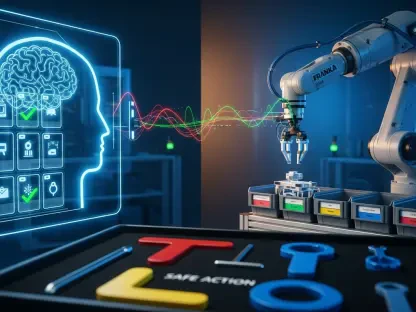The evolving landscape of AI chatbots is not just confined to their current functionalities but is set to undergo transformative advancements that will embed them even more deeply into various facets of daily life and business operations. AI chatbots have shown considerable financial potential, and the industry is projected to burgeon to $9.4 billion by 2024, primarily driven by rapid advancements in artificial intelligence and machine learning technologies. The significance of this trend cannot be overstated, as chatbots are poised to revolutionize sectors ranging from healthcare and finance to retail and education. As these technologies advance, they promise to offer unprecedented levels of efficiency, personalization, and convenience.
Emerging Trends in AI Chatbots
One of the most significant trends is the development of voice-activated AI chatbots, building on the existing success of platforms like Amazon Alexa and Google Assistant. Voice-interaction capabilities are anticipated to enhance convenience and accessibility, extending beyond traditional text-based interfaces. For instance, users might interact with chatbots through their car’s voice assistant, enabling seamless, hands-free management of tasks such as booking appointments or setting reminders while driving. Voice-activated chatbots are uniquely positioned to integrate into everyday environments, from home automation systems to wearable devices, thereby making user interactions more fluid and natural.
Another pioneering trend is hyper-personalization, which will see AI chatbots evolve from current personalization practices to interactions that adapt to users’ emotional states and historical data. Hyper-personalization holds substantial promise in fields like healthcare, where individualized patient care informed by comprehensive patient histories can significantly enhance the quality of service delivered. For example, a healthcare chatbot might adjust its responses to support a patient experiencing stress or anxiety, offering more empathetic and contextually appropriate advice. This level of personalization could also extend to other areas such as education, where chatbots might tailor learning experiences based on a student’s progress and emotional state.
AI-Driven Decision-Making and Cross-Platform Integration
AI-driven decision-making is another trend that is set to redefine the role of chatbots, evolving from mere responders to entities capable of making well-informed decisions. In the finance sector, for example, chatbots could analyze real-time market trends and recommend investments, thereby functioning as integral tools for personal finance and investment management. Imagine a chatbot that not only helps manage your budget but also provides tailored advice for optimizing your savings and investment strategies. This capability could transform how individuals and businesses manage finances, making expert advice more accessible and actionable.
Cross-platform integration promises to offer seamless, omnichannel customer experiences by providing context-aware service across multiple devices. Users could initiate an interaction on a laptop, continue it on a smartphone, and conclude it on a smart home device without losing any contextual continuity. This trend highlights the potential for chatbots to offer uninterrupted service, making them indispensable tools in sectors like retail and e-commerce. For instance, a chatbot could help a customer start a shopping session on a desktop, recommend products on a mobile app, and finalize the purchase on a smart home device, providing a seamless and cohesive shopping journey.
Industry-Specific Impacts
The healthcare industry stands to benefit immensely from the advancements in AI chatbot technology, with potential applications in telemedicine, appointment scheduling, and patient monitoring. Companies like Babylon Health have already begun deploying chatbots to assist with symptom checks and medical advice, enabling healthcare providers to manage patient loads more efficiently. In education, chatbots are poised to serve as virtual tutors, offering personalized learning experiences and administrative support. Duolingo’s interactive language-learning chatbots are a precursor to the type of personalized education that could become the norm, offering tailored learning paths based on individual student needs and progress.
In the financial sector, AI chatbots are likely to become integral to customer service, fraud detection, and personalized financial advising. Bank of America’s Erica chatbot exemplifies how such technology can manage transactions and provide proactive financial insights. Similarly, in the retail and e-commerce sectors, chatbots will continue to play crucial roles in product recommendations, order management, and customer query resolution, thereby boosting both customer engagement and sales. H&M’s chatbot, which offers personalized fashion advice, exemplifies how chatbots are improving the online shopping experience, making it more interactive and satisfying.
Challenges and Ethical Considerations
Despite the promising advancements and broad applications, significant challenges must be tackled for AI chatbots to reach their full potential. Data privacy and security are among the foremost concerns, especially as chatbots increasingly handle sensitive personal and financial information. The risk of cyberattacks and data breaches rises concurrently, necessitating stringent privacy measures and regulatory compliance to safeguard user data. Developers must prioritize security protocols and ensure adherence to regulations like GDPR to build trust and reliability in these systems.
Ethical considerations also represent crucial challenges in the evolution of AI chatbots. As chatbots become more autonomous and capable of making decisions, transparency and accountability become paramount. There are unresolved questions about liability when a chatbot errs or displays bias, particularly in high-stakes areas like healthcare or financial advisement. It’s essential to establish clear guidelines and ethical standards to ensure that chatbot interactions remain fair, unbiased, and accurate. Moreover, finding the right balance between automation and the human touch is vital. While AI chatbots can drastically improve efficiency, they lack the emotional intelligence inherent to human agents, making it important to integrate AI capabilities with human empathy.
The Future Outlook
Experts widely recognize the transformative potential of AI chatbots, yet they also urge caution in navigating their ethical and practical complexities. Dr. Jane Smith, a leading AI researcher, predicts an era where AI chatbots could rival human agents in certain contexts, especially in providing highly personalized customer service. However, she emphasizes that upholding ethical standards and ensuring transparency will be critical to their successful integration. Professor John Doe echoes this sentiment, highlighting the necessity of accountability as chatbots gain increasing autonomy in decision-making processes.
In conclusion, the future trajectory of AI chatbots holds tremendous promise but also significant challenges. As businesses and individuals prepare to integrate these advanced technologies, understanding the emerging trends such as voice activation, hyper-personalization, AI-driven decision-making, and cross-platform integration will be crucial. Addressing the inherent challenges of data privacy, ethical considerations, and balancing automation with the human touch will be essential for ensuring that AI chatbots remain beneficial, trustworthy, and user-friendly. This balanced exploration provides a comprehensive understanding of how AI chatbots are set to reshape various industries, promising a future enriched with technological efficiency and personalization.









